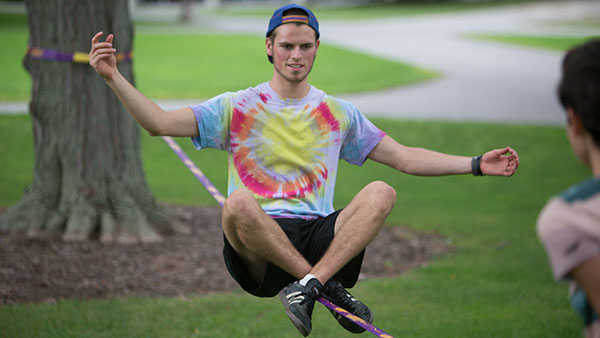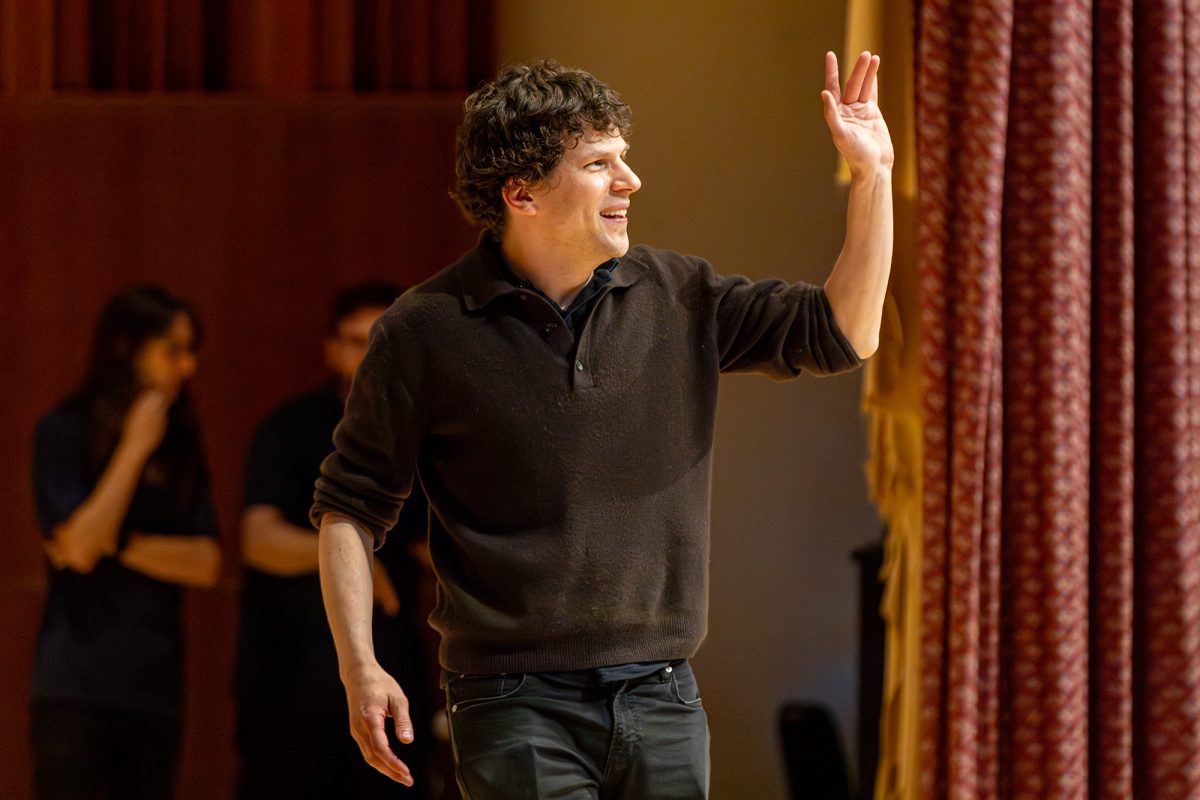Locked in a focused stare with her arms hovering just above her head, junior Natalie Dionne floats in the air. She is barefoot, framed between the trunks of two hulking trees, her toes perched on a slim, red ribbon of flat climbing rope. It rocks, wobbles and shakes as she brings her foot forward, laying it down carefully in front of her. Just a few feet away from her, between another pair of trees, sophomore Sean Phillips hangs just above the grass, crouched stoically on a similar stretch of purple line. All the while, passersby stare at the pair with curiosity, enamored with the two and their triumphs against gravity.
But this is no circus act: These two are not performers. This impressive display of poise is slacklining, an outdoor activity similar to tightrope walking that has fostered a new, adventurous community over the last few decades. With roots in the rock-climbing scenes of the ’70s and ’80s, slacklining is an activity that encourages personal exploration, inner peace, unending focus and, above all else, an ineffable sense of balance.
The premise is simple: Participants take a length of flat climbing cord, also called webbing, and string it up between the trunks of two anchor points, typically trees. From here, the line is pulled taut. Traditionally, adequate tension is achieved through the use of knots and carabiners, though some modern webbing made specifically for slacklining features a ratchet system for tensioning the line. Once tightened, the line is ready to be walked, lept and balanced upon.
But what the world’s many “slackers” do on their lines is entirely up to them. Frederik Zimmermann, who sits on the executive board of the Germany-based World Slackline Federation and judges slackline competitions, said it’s the open-ended nature of slacklining that makes it an attractive form of recreation.
“You can make it what you want,” Zimmermann said. “If you just want it to be a recreational activity, that’s fine. If you’re ambitious, if you want to achieve goals, you can do so. Slacklining is what you want it to be for yourself.”
For Dionne, who picked up slacklining when she was 16 during a vacation in Bar Harbor, Maine, her time on the line is tranquil. She is content balancing on her line, and while she will every now and then take a cautious step, she is usually still on the line. It’s these placid moments that she said bring her peace.
“I love just balancing and just interlocking your feet with the line and trying to find your center point,” Dionne said. “I think there’s a very cool harmony that’s created when you’re just balancing.”
This emphasis on inner peace is a concept near to the hearts of many slackliners. The activity takes a role akin to yoga, quieting nerves and quelling the stresses of everyday life. Phillips, whose interest in rock climbing led him to slacklining, frequently joins Dionne on her slacklining ventures, though his approach is not nearly as serene as hers. His style is cathartic, and next to Dionne, Phillips is animated, bouncing on his line with visible enthusiasm. He said slackline provides an opportunity to escape stress and quell daily anxiety.
“It’s just such a stress reliever, to take a slackline out, put it in the center of campus,” Phillips said. “Even if you have a lot of craziness going on in your life, if you want to be able to slackline, you need to calm yourself down and really focus.”
But slacklining isn’t just a solitary pursuit. Often, it’s enthusiastically social, drawing in curious onlookers itching to test their balance. Phillips said this inviting quality of slackline is something that adds value to the entire experience.
“One of my favorite parts about it is just the social aspect of it on a college campus,” Phillips said. “If I put up a line in the center of campus, there will probably be 15 people during the day who will come by and be like, ‘Oh that’s awesome. I want to try that.’”
This alluring aspect doesn’t come as a surprise to Zimmermann, especially in regard to college campuses. The longtime slackliner said the intriguing pastime provides the social and physical recreation sought after by younger individuals.
“Young people, students on campuses, they try to find something that is social,” Zimmermann said. “So if you look at slacklining, it’s everything that young people want to do: You can combine it with parties, you can do it in groups or just use it for recreation in between classes.”
However, the world of slacklining isn’t always taking it easy. As much as slacklining can be a leisurely diversion, it can also be an intensely physical and mentally strenuous sport. Many slackers have begun performing elaborate acrobatics on their lines in a sport called “tricklining.” These adrenaline junkies bust out backflips and more, all while miraculously maintaining their place on their line.
Others, including Zimmermann, have taken to “highlining,” with stretches of webbing spanning massive, perilous drops. The German slacklining aficionado has traveled nation to nation, setting up in Germany and Scotland, to name a few. But even with his veteran status in the scene, Zimmermann is consistently amazed with the slacklining community and said from what he has seen, he expects the community to keep on growing.
“I grew up with the sport, and every year, every week, every day I am more and more amazed about what can develop,” Zimmermann said. “Nothing is impossible: Everything we can imagine, can happen in slacklining. That’s what I truly believe.”
But no matter how it’s done, be it a quiet summer distraction or something more extreme, Dionne is hard-pressed to declare any one style good or bad. While she will admit that she thinks the extreme offshoots of slacklining are “crazy,” she finds the activity in any form to be a wholly internal experience and said ultimately it is a personal pursuit above all else.
“I think it’s very hard to put a general consensus on ‘Oh, you’re good at slacklining,’ or, ‘You’re not good at slacklining,’ because it’s a weird thing. It’s not a point basis,” Dionne said. “You can’t slackline for anyone but yourself.”














